What images Say: On Amateur Photographs & Ways To See Them
“I’m writing this while listening to news of devastating fires in California. Climate change has made catastrophic fire events a new normal in Western North America. Every household is now urged to put together a ‘go bag’ or ‘bug out bag’ against potential evacuation, including identification and ownership documents and family photos. These days, as often as not, the photos will be on a memory stick. But, inevitably, the contents of the go bag will be neglected or reviewed and replaced. Perhaps the memory stick will be pulled and replaced or will be found to be unusable. Perhaps, just like analog photos of old, the digital file names will become enigmatic to another generation, muting clues to the meaning of the images.”—William Ramp
Small Things Recollected
By William Ramp
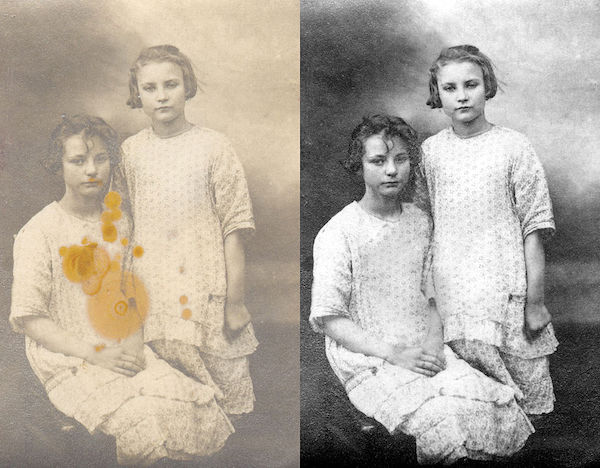
LETHBRIDGE, ALBERTA Canada—(Weekly Hubris)—December 2018—I’m a habitual browser of antique stores when I find the time, and when I eat at an establishment featuring some pastiche of “period” décor, I need to be prompted to eat rather than studying artifacts wired to the walls. But this can be a painful pastime.
Antiques are now bought and collected mainly as décor items. Their provenance, beyond a very rough periodization in terms of style, is less important. It’s hard to see old books that might have thrilled some Victorian reader displayed for atmosphere, all the interpretive possibilities of their inner texts, gift inscriptions, annotations, and owner’s bookplates left unnoticed.
Harder still is to encounter dozens of old photographs jumbled together in antique mall displays. The faces in these are orphans; the names on the back, if there are any, unrecognizable and unimportant to idle browsers. Decades ago, some young woman posed, laughing or pensive, with a dog or a cat, beside a car, on a beach. Who was she? Who once delighted in her image? Who eventually chucked it out, saying some version of, “I don’t know who these are anymore. They’re just taking up space, right? Out they go.”
That’s the thing. Even many old photos we do decide to keep until the next household purge, knowing that they depict “family,” are often already lost to us. You may have inherited a collection of slides, snapshot prints, or old studio portraits from an older relative who has died. Did that relative know so well who was in the pictures that they didn’t bother to record full names or locations on them?
Let’s imagine a different kind of relative, one keenly interested in family history. Others in the family, knowing that interest, have left the archiving to her (I choose the pronoun deliberately; so often, the informal family historian was a woman). For years, she’s saved news clippings and swept up the documentary discards and detritus of her ancestors, siblings, and cousins, storing it all against the time when there would be time finally to sit down, go through it all, add names and other details to the backs of images, write up a proper family tree, record the stories. All too often, the time never comes; the work of systematizing, noting provenance, adding identifiers is begun but left off when one no any longer has the energy, strength, or ability to complete the task—or when one dies, surprised by the scythe, with fondly self-allotted time to finish things still on the imaginary clock.
Then, the documentary artifacts of one, two, or three hundred years must be sifted by executors and legatees who all have lives to live and other things to do. The house or apartment must be emptied quickly to be put back on the market. Who these days has storage space eagerly awaiting heritage furniture, hand-made doilies, boxes of paper, old books, old tools, old stuff? Who among the harried sifters will hold up a sepia portrait marked on the back as “Bob” or “Uncle Jim” and exclaim, “I know who this is! Keepers!” Even if they could, would they want an image of some relative they may never have met and know nothing about, attached to ancient, acidified, and crumbling card stock, with silver ghosting through to the surface (making it impossible to scan) and, as often as not, creased or in two or more pieces?
Add to these the scores of snapshots, their negatives lost, boxed, re-boxed and shuffled around over 80 or a hundred years. Faded, ill-taken, black and white images, usually unidentified or with a single, enigmatic word or two: “Trip up north,” say, or “Lois.” Color slides and photos from the 1950s to the 1980s can present even worse nightmares; often faded beyond saving unless you really know your way around photo editing software or have access to a conservation lab.
I’m writing this while listening to news of devastating fires in California. Climate change has made catastrophic fire events a new normal in Western North America. Every household is now urged to put together a “go bag” or “bug out bag” against potential evacuation, including identification and ownership documents and family photos. These days, as often as not, the photos will be on a memory stick. But, inevitably, the contents of the go bag will be neglected or reviewed and replaced. Perhaps the memory stick will be pulled and replaced or will be found to be unusable. Perhaps, just like analog photos of old, the digital file names will become enigmatic to another generation, muting clues to the meaning of the images.

Each generation tends to record only enough of its history to remind itself of what it already knows. But death or other forms of oblivion come too quickly, and the tacit knowledge of each generation—everything it was assumed everybody knew—evaporates with it. The last options for those burdened by things that once meant much to their forebears are secondhand stores, auction houses, collectibles dealers, museums (which have accessions policies to restrict the influx), or the second-hand shops run by charitable organizations or their commercial emulators. These are often the selective pipelines to retro décor culture.
Or there is one other option: the still-living relative who is a known collector.
Recently, I helped a cousin go through her late mother’s effects, collected over an active and healthy life of nine decades. On an earlier visit, the three of us had spent two productive evenings identifying family photos and other items. We thought we’d done well. But this time, several days of sorting through the house unearthed many more bags, boxes, drawers, and shelves of memorabilia, including hundreds more old photos. Our dilemma in the face of these will be familiar to most who’ve helped clean out a house. What does one do with undocumented documentation?
My cousin and I managed to put names to a few images, but many, many more seemed hopeless. Should we chuck them? “You can’t keep everything!” say the sages. But I’m one of those who wants everything kept, and I accept things I’m given by others grateful for help with the hard decisions. Someday, unless I change my ways, my own children will face a godawful task as a result. As they keep reminding me.
This time, I was gifted or lent enough photographic and other material to fill an extra checked bag. When I hauled it into my overstuffed apartment, all optimistic calculations of available space evaporated, as did the time I’d imagined would be available to research the items. As always, such are the consequences of loving too many orphaned things too much.
In this column, I’m going to open the bag, and a few other boxes accumulated over the years. Let’s see what interpretive possibilities might reside in a selection of old family photos, including unidentified and unidentifiable ones. Let’s dip a toe into the foreign country we call, patronizingly, “back in the day.”
Fear not: this will be neither Dad’s Family Slide Show nor a quest for “human” universals. Let’s look at these images as cultural artifacts. If they can’t tell us specifically who “Aunt Jane” was, nor what we’re all like, maybe they can still say something about technologies, techniques, and materials; about possessions, relationships, families, ways of life, fashions; about change and revolution. Maybe they can also tell us things about ourselves. Watch how, in my comments below, I negotiate family membership, academic training, cultural habituation, and personal impression.
How would you respond differently? What different things do you see? What surprises or disconcerts you?
Does this approach sound trivial or idiosyncratic? Well, the definition of trivia is always relative and provisional, and attending to the idiosyncratic can reveal the politics of relevance.
A word about the materiality of these small things recollected. Members of my family were early adopters of Kodak roll-film cameras, popularly known for decades as Brownies. They were taking snapshots in the first decade of the 20th century, and my grandfather purchased and used his own developing equipment. But these early mass-produced cameras were prone to light leaks. There was no focus control and exposure metering was accomplished by guess and by gosh. Film advance was easily forgotten or miscalculated: double-exposures and half-exposures abounded as a result. And these eager snappers were no experts: many of their images are over- or underexposed, or both. Composition is haphazard: feet, arms, and heads are amputated. As is still the case today, numbingly-predictable straight-on portrait and group arrangements appear over and over.
But, every now and then, even an inexpertly posed or composed photograph exhibits something far beyond its capacity and becomes arresting: a thing of beauty or compelling weirdness one is drawn to again and again.
The earliest snapshot prints are usually small, but the sizes and shapes vary wildly. Generally, the very early snapshots have stood up well: fading and silvering are minimal. Glossy sepia prints from the 1910s seem to fade far more readily, as do early color prints. I have included one or two possible studio photos in my lineup: these are not always of better quality than some snapshots, and sometimes it is apparent that a studio has been employed to blow up and mount a snap.
Even the best studio photos can exhibit particular kinds of carelessness, such as soft focus or overexposure. Scan one and try to line it up with Adobe or some other photo-editing software, and you will find often that the card stock is not cut straight, nor is the image pasted to it. Often, the image will be slightly, irritatingly askew from the embossed rectangle that frames it.
The card stock used to mount early 20th-century studio portraits was often more elaborate than the cabinet cards of the 1880s and 1890s; embossed, of different colors or textures, with hinged covers or supports to sit upright on a piano or mantelpiece. But many of these are now crumbling while the earlier cards stand up relatively well: a higher acid content in the stock tells against them and does no favors to the images they enclose.
Here goes, then. Suspect #1 to the stand, please.
![]()
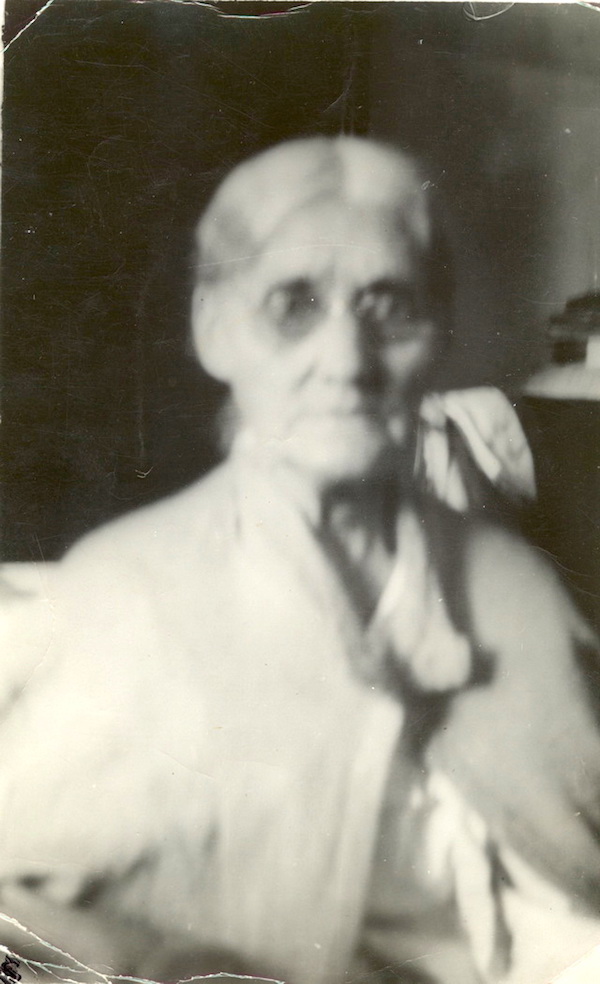
This image haunts me. It is an indoor snap of a great-great aunt, taken in the 1930s. She married late in life a widowed, small-town doctor and went with him hundreds of miles away from the rest of her family. The doctor died, his children moved away, but she stayed on alone in a tall, red-brick Victorian Gothic house with a four-story tower. She was the keeper of memories and artifacts from the first generation of the family’s settlement in Canada. She appears to have been a starchy, independent type, but she was a regular correspondent. Something in those letters eventually triggered worry in a recipient or two. My grandfather loaded his family into a brand-new black ’35 Dodge for an investigative trip. They set out down narrow two-lane highways that still went straight through Victorian gingerbread towns, past new art-deco factories and over steel bridges, along shipping canals and rivers, visiting various relatives along the way.
When they arrived at her place, they found the downstairs nearly empty, save for a dining room table and a few old upholstered chairs that split and gave up puffs of dust when the children sat on them. She was confined to the second-floor tower bedroom, too arthritic to walk, and with her best china and keepsakes kept under the bed. Hired help had seen to her basic needs. It appears she took a shine to my grandmother, and a number of keepsakes came our way as a result. It was arranged that she enter a nursing home run by a younger colleague of her dead husband. It did not go well.
This photo is from that trip, and despite the focus issues, someone thought enough of it to order a 4 X 6 print. I look at it and see someone no longer known well, perhaps not even to herself; a well of loneliness; repository of a past only she now remembered.
![]()
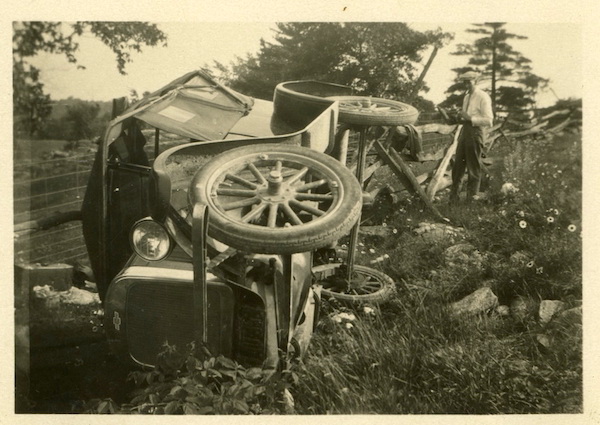
I chose this snapshot because it is a miracle of decent composition, exposure, and focus. It tells all that needs be told. But the viewer begs for more. Nothing is written on the back, and my mother does not recall the incident. Whose car was it? How did it come to overturn? This photo was in the same box as others from the road trip I described above. I surmise it was taken somewhere in the Shield country of Eastern Ontario; that my grandfather and family happened upon the scene, and stayed to help out in some way. Perhaps the gent standing in the background is the driver, having a steadying cigarette. We will never know.
![]()
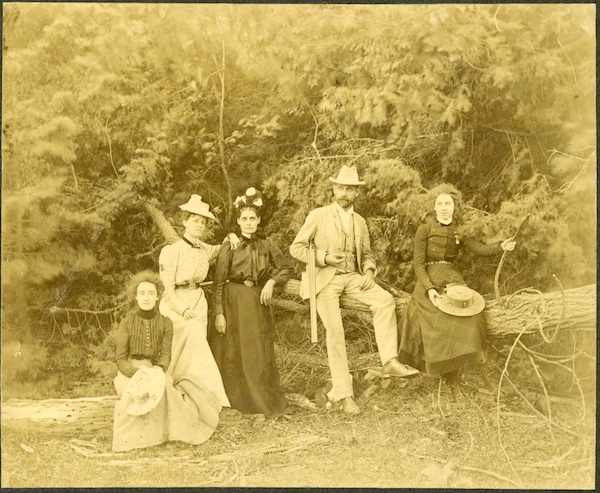
This sepia image, taken on the cusp of the 20th century (September 4, 1900), may have been done by a professional; it is sized up, but the detail is still nicely crisp, and it has been pasted onto a stock card backing. It features, at center, the same woman as in the first of the two previous images, in happier times though she is unsmiling. The man is her brother, a successful small-town lawyer. The woman second from left is his first of three wives; he was widowed twice.
He looks a lot like Bernard Berenson, the once-famous art historian and dealer; perfectly trimmed and turned out, sociable, alert for the main chance, just a bit scoundrel-ish. He’s not dressed for hunting; none of them is, but he holds his father’s double-barreled rifle/shotgun; a telling detail of pride in settler history. Its importation into what is emphatically a romantic, sylvan setting, is telling.
This is settler nostalgia for the forest, in an area of the country which had been denuded of its forests by the Booth Lumber Company, whose principals may have been known to one of these figures. The forest glade here is a background prop for an imagined hunting exploit; for exploitation; for opportunity. One is tempted to make something of the fallen tree our ersatz hunter sits upon. But that might be an interpretive step too far,
![]()
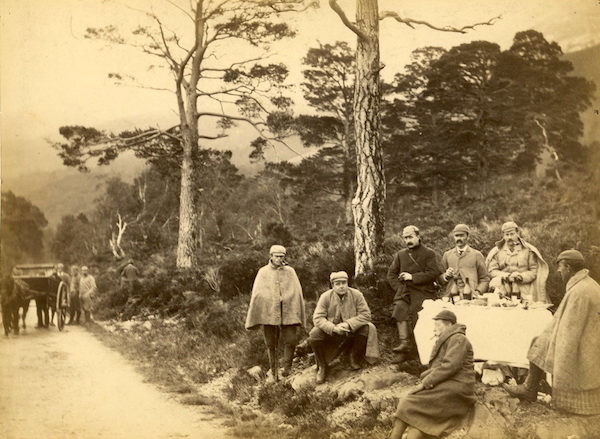
This image has been inexpertly and crookedly pasted onto a generic card backing. It was taken in 1888 by someone working a bellows camera and depicts a group of Victorian gentlemen somewhere above Loch Maree in Scotland. One supposes they have been hunting or fishing, or both, but the real object of the expedition appears to have been gustatory. All that wine!
The wary gent in the light-colored cap and jacket behind the table, holding a cigarette in his fist, is George Cuthbertson Duncan, M.D., brother to the lawyer in the previous image. At the time, he was a successful medical practitioner in Wimpole Street, London, having left an upper-Canadian farm in the 1870s to take a degree at McGill, where he crossed paths with William Osler, already bound for glory, and the serial murderer Thomas Neill Cream. All three followed the lure of trans-Atlantic opportunity.
The elderly fellow seated in the foreground just may be his mentor, Sir Henry Thompson, a medical practitioner who saved the life of the King of the Belgians (one desperately wishes he hadn’t) and lost that of Napoleon III.
Within a few years, Duncan would abandon medicine for the headier and shadier occupation of dealer in old master paintings and old master violins. He became very quickly wealthy—a little too quickly, perhaps. He claimed to have purchased a document giving the “secret” to Paganini’s devilish playing, and another giving the varnish recipe used by Cremonese master luthiers. (Varnish, suitably aged, it may be noted, can cover a multitude of sins, both on “old master” violins and on “old master” paintings.)
In later life, he lost his money, first in futile legal action against the Italian government, which barred him from taking his art collection out of the country; then in the obsessive purchase of junk that he persuaded himself was worth thousands, and finally in old age by falling in love with and believing his own tales about the remaining 157-odd paintings and thousands of violin parts he stored above a stable in east London. They were all auctioned off for pennies after his death in the depths of the Great Depression, in a room at the Charing Cross Hotel, where a staff nurse heard his final ramblings about his beloved pictures. His Canadian family knew little of this; they believed him as he did himself.
Oh! The dude wearing the deerstalker and smoking the Meerschaum, you ask? Who else? Surely, Doctor Watson, you recognize his most obvious of disguises?
![]()
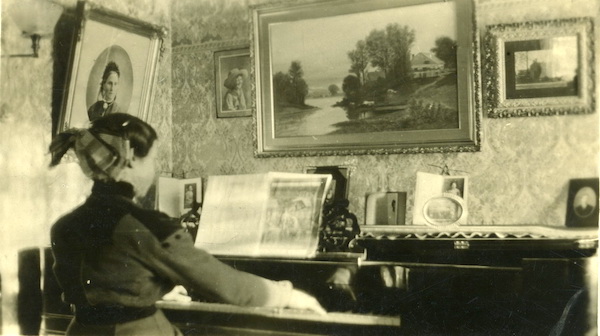
This photo is a Brownie “snap,” as they were then called, dating to about 1911. It’s a rarity in any family shoebox: there are few early snapshots of interiors. Most home camera enthusiasts did not own flash equipment which, in those days, was finicky, even dangerous, and gave hilariously horrifying photographic results. But without a flash, there wasn’t enough light for a good picture. Unless, that is, the piano was situated just at the right distance from the window, and the sun at just the right angle at the right time of day, and the curtain sheers ready to diffuse the light just-rightly.
Here we have a near-miracle of decent exposure, giving us a Victorianist’s dream. The wallpaper! The furnishings! The clutter of studio card photos! The stern ancestor framed in gilt-plaster on the wall! The gas fitting! The pianist’s dress! That exuberant bow in her hair! The gloomy amateur oil painting! The double runner on the piano top! And above all, the piano!
This was a Southern Ontario farmhouse parlor, and the pianist’s father was a respectable local farmer. Such as he were easy prey to itinerant piano salesmen who toured the prosperous turn-of-the-century countryside signing up orders. In the days before recorded music, a piano was just the thing for home entertainment, and for showing off the skills and refinement of your marriageable daughters.
I find it interesting that the two most popular home musical instruments of the time were employed in highly gendered ways. The fiddle was mostly for men. It could evoke tears with weepy Scots or Irish airs but could also scrape out racier tunes in barns and taverns. The piano had a barroom life, too. But here, it is genteel. It speaks of class and respectability. It shows off correct posture, which was, at the time, taken to be an indicator of moral fiber, and of something once called “breeding.”
But respectability exacted its price. Walter Benjamin sensed that when he wrote this vignette:
In my room, we got to talking about the “piano” as a piece of furniture that functions in the petit-bourgeois interior as the true dynamic center of all the dominant miseries and catastrophes of the household. Asja was electrified by the idea; she wanted to write an article on it with me which [Wilhelm] Reich would then turn into a dramatic sketch. (Walter Benjamin, from Moscow Diary),
Electrification came, and with it came a new popular culture which would eventually blow away petit-bourgeois respectability and sentimentality alike.
![]()
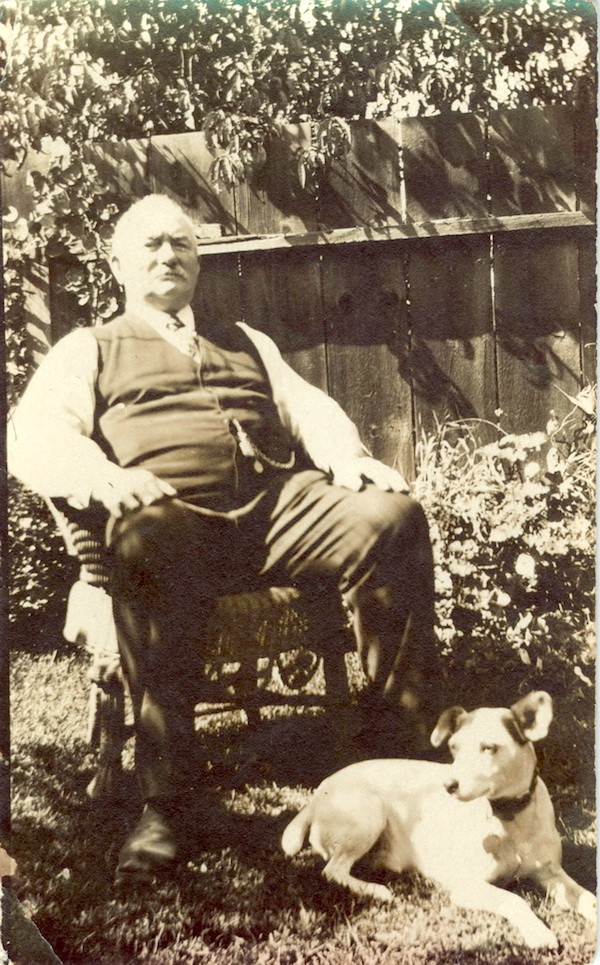
John Addison, Right-of-Way Agent for the Toronto, Hamilton and Buffalo Railway, and his dog, in about 1920. If anyone could sweet-talk a widow woman out of a tract of land or provide the subject-matter for a snapshot artist skilled enough to crouch down for a low-angle shot, it would be he. Personality by the bushel-full, and it’s all on expansive display here.
![]()
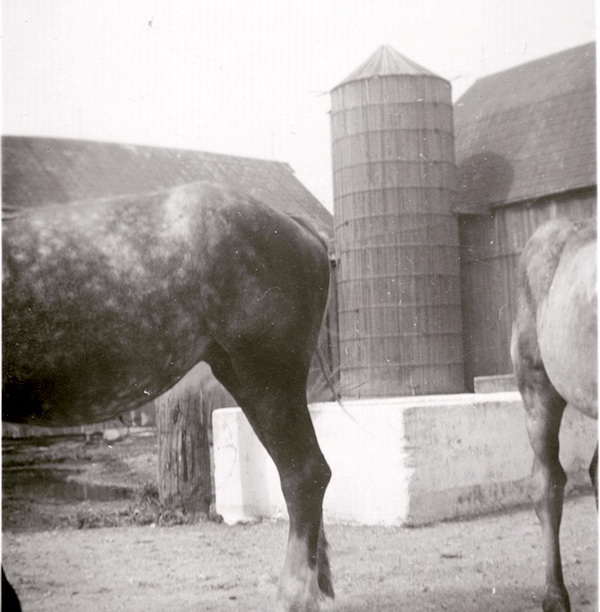
This. THIS! Oh, the unintentional but utterly wonderful surrealism of a century-old farm-yard snapshot. This is a composition fail of the very best sort.
![]()
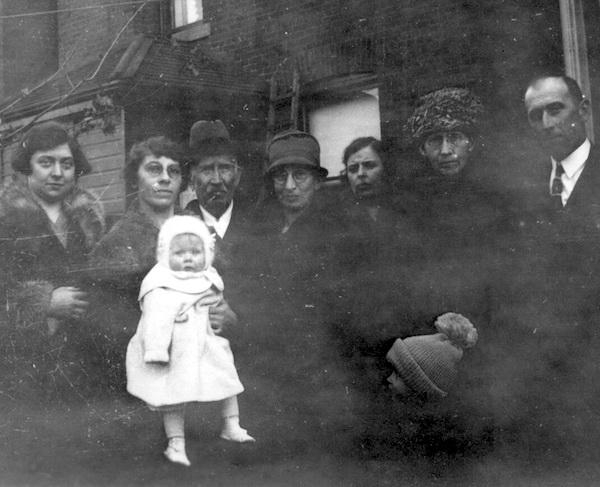
This is a badly-lighted and badly-scarred photo that I find utterly compelling, in part because of its badness. The infant in white seems to float on, but not of the dark air of which she is oblivious. The toqued child in the lower foreground stares up at her intensely, as if from another, shadowed realm, and above them both—Look! —those adult faces, arranged as if by a late-Flemish or Caravaggiesque painter of apostles startled by the irruption of an angel or a Christ in their midst; their faces showing the pride, preoccupations, desires, and sufferings they have brought to this moment and through which they experience it. “Now we see through a glass darkly,” said the Apostle Paul . . .
![]()
There are more, many more, images like these that I could have chosen to write about. They are no more exceptional than those that inhabit thousands of attics and closets. They just need an eye to see something in them. My eye. Your eye.
Find. Look. See.
![]()
References
“. . . unless you really know your way around photo editing software or have access to a conservation lab.”
—See title image at top, and “Image 1” under photo credits below.
“. . . a ‘go bag’ or ‘bug out bag’ against potential evacuation, including identification and ownership documents and family photos . . .”
—Ashley Tressel, “Evacuation essentials: What should be in your ‘go bag’,” Ukiah Daily Journal, October 12, 2017: “If you have more time, take a second to also grab lightweight valuables, family photos and other sentimental items, a hard drive with your computer data and cell phone and laptop chargers.” (https://www.ukiahdailyjournal.com/2017/10/12/evacuation-essentials-what-should-be-in-your-go-bag/)
“. . . with silver ghosting through to the surface . . .”
—See “forms of Photograph Degradation: Silver Mirroring,” Archives and Special Collections Blog, University Libraries, University of South Dakota, January 17, 2012. (https://archivesandspecialcollections.wordpress.com/2012/01/17/forms-of-photographic-degradation-silver-mirroring[RW2]/)
—For more information on types of photographs and their conservation, see “Photographic and Image Materials Cheatsheet,” Preservation Self-Assessment Program, University of Illinois at Urbana-Champaign (https://psap.library.illinois.edu/collection-id-guide/summary-photo), and also “Care, Handling, and Storage of Photographs,” Library of Congress (https://www.loc.gov/preservation/care/photo.html)
“What surprises or disconcerts you?”
—My approach owes much to Walter Benjamin’s “The Work of Art in the Age of Mechanical Reproduction” (http://web.mit.edu/allanmc/
“Such as he were easy prey to itinerant piano salesmen . . .”
—See Wayne Kelly, Downright Upright: A History of the Canadian Piano Industry, Dundurn Press, 1992
“. . . Bernard Berenson, the once-famous art historian and dealer. . .”
— See “Bernard Berenson” at https://itatti.harvard.edu/
“. . . George Cuthbertson Duncan, M.D. … claimed to have purchased a document giving the ‘secret’ to Paganini’s devilish playing”
— See The Musical Times, Vol. 24 (1883), page 614; also Warren Kirkendale, “Segreto Communicate da Paganini,” American Musicological Society journal, 18, Fall 1965: 394-407, and also John Dilworth, Andrew Fairfax, and John Milnes, The Voller Brothers: Victorian Violin Makers (British Violin Making Association, 2006)
“. . . William Osler, already bound for glory, and the serial murderer Thomas Neill Cream . . .”
— See “Sir William Osler,” The Canadian Encyclopedia, 2015 (https://www.thecanadianencyclopedia.ca/en/article/sir-william-osler), and “Thomas Neill Cream, The Canadian Encyclopedia, 2008 (https://www.thecanadianencyclopedia.ca/en/article/thomas-neill-cream)
“. . . his mentor, Sir Henry Thompson . . .”
— See “Sir Henry Thompson, 1st Baronet,” Wikipedia (https://en.wikipedia.org/wiki/Sir_Henry_Thompson,_1st_Baronet)
“They were all auctioned off for pennies after his death . . .”
—See “A catalogue of a collection of old and modern pictures and drawings, carved and gilt frames : by direction of the executor of the late Dr. G.C. Duncan … and from other sources.” London: Robinson, Fisher & Harding,1936, in Getty Research Institute holdings (http://primo.getty.edu/primo_library/libweb/action/dlDisplay.do?vid=GRI&search_scope=default_scope&docId=GETTY_ALMA21141743890001551&fn=permalink)
“Walter Benjamin sensed that when he wrote this vignette”
—Walter Benjamin (ed. Gary Smith), Moscow Diary (Harvard University Press, 1986)
Images
Image 1 Photo of Anna and Germaine Sierens, ca. 1924, before and after restoration. Photo restoration and copywork by Michel Vuijlsteke, on Wikimedia Commons (https://commons.m.wikimedia.org/wiki/File:Photo_restoration,_before_and_after.jpg#mw-jump-to-license). Shared under Creative Commons Attribution-Share Alike 3.0 Unported license.
Image 2 Red Cross “ready to go” preparedness kit, FEMA Photo Library, via Wikimedia. (https://en.wikipedia.org/wiki/Bug-out_bag#/media/File:FEMA_-_37173_-_Red_Cross_%22ready_to_go%22_preparedness_kit.jpg)
Images 3-8 Author’s private collection.
Images 9 & 10 Courtesy of Mrs. A. McMillan, personal collection.


2 Comments
Jean
Ah, this is a lovely meditation – and instruction – on the fractured memoirs of existence we call photographs. We, too, have had to make the dreadful pitch it or keep it decision, one that is, as you point out, frequently made under dreadful pressure and in less than ideal circumstances. Still, you inspire me. After the holidays, I have a trunk to go through… Thank you for this gentle examination of memory.
William Ramp
Thank you Jean, and I wish you a gentle go-through of the trunk, with a few moments of sheer delight to leaven it!